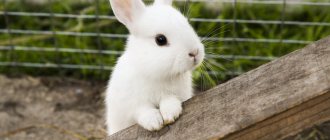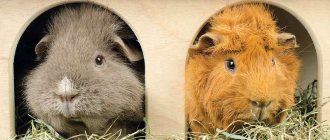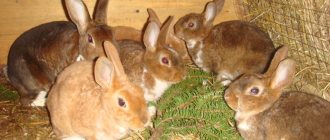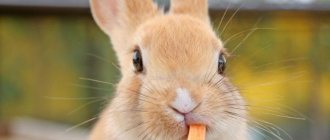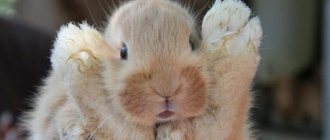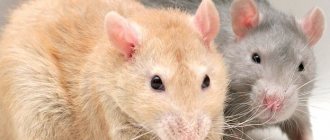Here is information about the pros and cons of keeping rabbits as pets. All information was compiled based on my and other people's life experiences. Be sure to read the entire page before purchasing a rabbit. This is in your interests and the interests of the animal, not to mention your household. And only after that decide whether to have a rabbit in an apartment or a private house.
Advantages:
- They get used to people and many pets, including cats and dogs.
- Dwarf rabbits are small, do not take up much space, eat little, and have little odor.
- Beautiful, fluffy, soft.
- They love to be stroked and, in turn, lick their owners.
- They cost less than the same chinchillas.
- A rabbit can be litter trained.
- A rabbit can be trained to walk on a harness.
- Rabbits love to play, and if you try, you can stop them from chewing wires and wallpaper.
- Rabbits are generally sociable.
- If you also have a cat, you can watch and participate in their games. True, it depends on the characters of the cat and rabbit.
Flaws:
- Rabbits have a lot of their own characteristics, including their content - they are worth knowing inside and out.
- The smell, and a very strong smell if you rarely clean the cage.
- The larger the animal, the more it eats and smells.
- Under no circumstances should you keep a rabbit in the same cage as a guinea pig.
- Rabbits love to chew wires and tear wallpaper; you still need to be able to wean them off this.
- It is more difficult to train a rabbit to use a litter box than a cat, but you will need to do this if you want to let him out of the cage and at the same time protect the apartment from white spots and feces.
- Dwarf rabbits are more susceptible to disease and are significantly more expensive.
- Decorative rabbits are larger in size than dwarf rabbits and have more odor.
- Rabbits are much more susceptible to disease and risk of injury than cats and dogs.
- To keep a rabbit you will need to buy various items, such as: a cage, a drinking bowl, a feeder. They need to regularly buy hay and dry food in granules.
- The temperament of rabbits, especially female rabbits, can be explosive. So, during the rut, one decorative rabbit dragged a huge Persian cat by the tail and pulled out tufts of fur from him, and when she was put in a cage, she shook the bars with her paws, chewed them with her teeth, and threw bowls around.
- If a rabbit doesn't like you sticking your hands into its cage, it may strike with its clawed front paws, and some rabbits may even bite.
- Have you heard the rabbits hissing and growling? If you're unlucky, you'll hear it.
- As I said above, you need to know the characteristics of rabbits. So, for example, they can scare an ignorant owner by falling on their back and rolling their eyes, but, by the way, they do this out of a great mood and pleasure. Or, for example, if the baby rabbits have diarrhea, then they must be urgently taken to the veterinarian, because without professional intervention they may not live even two days.
Is it worth having a rabbit in an apartment, pros or cons?
It is not human nature to listen to other people's opinions. How much did you listen to your mother, and then say, Mom, you were right, and even more so the opinion of Internet advisers on choosing animals. Meanwhile, rabbits are exotic animals for apartment keeping, and exotic animals require special knowledge. Therefore, read our advice, and then decide for yourself whether you are ready to take responsibility for a small living creature.
So, the topic of today’s review is decorative rabbits: pros and cons. How difficult is it to care for a small pet, how to feed it and what should you be wary of? Read about all this right now.
How to avoid diseases
In a greenhouse, it is impossible to achieve a level of sanitation comparable to cage housing. Feces and urine scattered throughout the area contribute to the development of coccidiosis. Therefore, animals must be given coccidiostats in a timely manner.
In winter, rabbit breeders fear frost. But he is not afraid of rabbits. And the greenhouse does not warm them, but only protects them from the wind. But due to the design features, excess moisture is created inside. Especially when there are a lot of animals. Such conditions contribute to the development of many diseases. The situation is aggravated by the evaporation of urine and the increased concentration of ammonia in the air. There must be ventilation.
When kept for walking in winter, it is better to plant only females in the greenhouse. The presence of males leads to indiscriminate mating. And if there are several of them, it leads to constant fights. Therefore, males must be left in cages.
If you spend time once and adapt the greenhouse to keep rabbits, you will get a full winter run for all subsequent years. This means you use the favorable summer time to maximize the reproduction of your herd. At the same time, after winter you get well-fertilized soil and high yields in summer.
Decorative and productive rabbits
Rabbits can be wild or domestic. Read all about wild rabbits. Domestic rabbits are divided into two types of economic use.
- Productive breeds are grown exclusively for meat, skins, and fluff.
- Decorative breeds and their varieties are dwarf and are raised only as pets.
In 1912, zoologists divided rabbits into two orders - rodents proper and lagomorphs. Since that time, rabbits, hares and pikas began to be classified as rodents (lagomorphs). So don't call rabbits rodents.
Read more: Why rabbits are not rodents
When you can’t get a decorative rabbit, pros and cons
It is strictly forbidden to purchase rabbits.
Don't get a rabbit as your first pet. Do not get a rabbit to play mother-daughter games for girls 10-12 years old. Don't let your first experience of future motherhood end with the death of your pet. The risk of death is very high. It's better to adopt a kitten from a shelter. This will be the best example of kindness for the expectant mother. Cats, physiologically, are much closer to people. They have the same type of digestion, they are smarter, communicate easier with people, and are more adequate.
Teach children responsibility and kindness, and not to fulfill the child’s every whim. Read the great Ukrainian and Russian teacher V.A. Sukhomlinsky.
Start at your discretion, but remember the characteristics of long-eared animals at home.
- Do not have pets under the influence of momentary sympathies.
- If you don’t know, the second most frequently asked question from lovers of decorative rabbits is the question in the search engine: why do rabbits smell? I’ll get ahead of myself and say that the smells are overfeeding the pet with treats.
- Not many people know that eating feces in rabbits is a physiological feature that cannot be weaned off. In all lagomorphs (lagomorphs), cecotrophy is a physiological feature of digestion. The rabbit is not a rodent; it belongs to an order parallel to rodents.
- For young families, an exception: if one of the members has been the owner of the animal for a long time. Build your relationship first.
- If you plan to have a little one. Definitely, the animal will interfere and distract the young mother from new and difficult responsibilities; do not torment the mother and the animal.
- One of the family members is against pets. Avoid unnecessary scandals with loved ones and family.
- Like a thoughtless purchase, at the child’s first request. Parents will take care, and the child, instead of kindness, will learn to shift his worries onto the shoulders of others. Or immediately take on this burden and explain to the child that this is not his whim, but the decision of the family council.
- The area of the home is so small that there is nowhere to turn around. Sometimes our housing is so small that its area resembles an enclosure for a large dog.
- Rented housing is also not an option. Rental conditions may change; constant moving does not contribute to normal conditions for the pet.
There are other options, they can be listed for a long time, based on the characteristics of each family, and determine for yourself the pros or cons of a decorative rabbit in the house. But if you are determined to get a rabbit, then read on, perhaps you will only become stronger in your desire to care for a cute bunny.
Small breeds
These small pets weigh no more than 1.5 kg and are 30 cm in length. These breeds live 6-12 years.
They do not need special care and are not picky about food. These animals are playful and cheerful. They were often kept as pets.
Angora breed
This species originated in Turkey. It was bred to produce down, which is then used to make Angora wool. The Angora rabbit is very beautiful, it can be of different colors: black, white, red, silver, chocolate.
This is a very shy animal. There is no need to make sudden movements around them. Rabbits are very friendly and playful.
They can be taught to follow simple commands, and they remember everything thanks to their intelligence.
These individuals are also distinguished by the fact that no sounds come from them; they are silent. In 1 year, a female rabbit can give birth to up to 10 cubs.
The main disadvantage is that they chew everything that gets in their way: furniture, wires.
White down
This breed was bred in Russia. Our country has long been famous for down products. It is for this purpose that the white downy individual was bred.
The animal has long and silky fur. The eyes are pink. This is a friendly and calm breed. The female bears up to 12 rabbits per year.
They grow quickly and by 2 months. the babies are starting to give off fluff. In photographs, the white fluffy bunny looks like a small ball of air.
Chinchilla rabbit
This species was bred in France to imitate the expensive fur of a chinchilla. And they achieved excellent similarity.
Our country has become very interested in this breed. But this species could not fully exist in our country due to the fact that the climate was not suitable for the individuals.
The weight of such a rabbit reaches 5 kg, body length - up to 60 cm. The offspring of females is small, about 8 rabbits. The breed is valued for its high quality skin and a fairly large amount of quality meat.
Soviet chinchilla
This is a popular breed that is bred to obtain skins and the required amount of dietary meat.
She was bred from a French rabbit and got a breed that survives well in our climate zone.
- It has a silver-blue color, and its ears and tail are black.
- The quality of the fur is valued for its thick and uniform texture.
- In the first months, rabbits grow very quickly, but later this process slows down.
- This is an unpretentious animal that does not require complex care. The main thing is to keep the cage clean and change the water. In winter, it needs to be heated, and in summer, do not place the cage in the sun.
Rabbit breed "Soviet Marder"
This breed was bred in Armenia. It got its name due to its resemblance to a marten. This species lives in the South and is a heat-loving species.
The weight is small, about 3.5 kg. And the height is up to 50 cm. Rabbits need to be fed often, with fresh food. This breed is susceptible to various diseases, especially having a weak gastrointestinal tract.
The animal is highly valued for its thick and soft dark brown fur. Female rabbits are fertile; they have up to 10 babies in their litter.
After reading the description, let's move on to the photo and look at all types of rabbits.
An animal is not a child's toy
This is the first thing to realize. Despite their miniature size and usually affectionate nature, rabbits will require attention, affection, special food, and special care products.
Dwarves are sometimes very aggressive, even more so than giants
Before you get a rabbit at home (and this must be explained to your children), you need to take care of the mandatory conditions for keeping a dwarf rabbit at home:
- spacious cage;
- the rabbit owner has free time when he needs to take his pet for a walk;
- proper nutrition and veterinary care;
Rabbits do not tolerate moving and travel well. How to transport rabbits and other animals within the country and abroad, find the section veterinary certificate form 1 veterinary Rosselkhoznadzor. It is clear that it is difficult to understand the cavalcade of documents, but find your region in the search at the top of the page of this site. If necessary, contact inspectors in your region by phone. We are obliged to help you. In any case, you will know what requirements need to be met when crossing the border with an animal and more. Perhaps the information from the site will help you make a choice when buying decorative rabbits. Rabbits can be long-haired or short-haired.
Is it worth having a rabbit for children? Pros or cons?
The kids really like cute miniature creatures. However, the child needs to understand that squeezing a “living toy” will have to be done carefully. It is necessary to take into account not only the desires of the child, but also the desires of the rabbit; although he is small, he is a living creature.
The rabbit does not bite often - more often it just hits the offender hard with its hind legs
Photo. Before buying a rabbit, we present the picture like this
- At the slightest change it can become aggressive.
- Baby rabbits should be purchased only from trusted breeders, or at a pet store.
Walking outside the enclosure
In addition to spending time in the enclosure, it is not only possible, but also necessary to play with the rabbit outside of it. This way, you will bond with your rabbit and he will be able to roam outside his enclosure. However, walks outside the enclosure should be taken seriously.
Firstly, it is worth fencing off all places that are dangerous for the rabbit. Such as wires lying on the floor that the rabbit can chew and cracks between furniture that the rabbit can crawl into and not get out. Secondly, think over his leisure time and surround him with your care. For leisure, a variety of toys that can be found in a pet store are perfect.
You can let your rabbit out for a walk at any time of the day for an unlimited amount of time. But you should not leave the rabbit in the apartment unattended, as something could happen to it outside the enclosure.
Can a decorative rabbit be huge?
It is believed that a home decorative pet must be a small animal. This is wrong. Maybe you are looking for a huge decorative rabbit. Then the old breed Flanders rabbit is your choice. The history of breeding this breed is very interesting and full of mysticism. Flandre is the largest rabbit, with an average weight of 12 kg. Flanders are common domestic rabbits in the United States that are bred as pets. In America, a program has been developed to teach children how to care for animals using the example of Flanders. The main breeds of giants, rabbit and ram, including dwarf breeds. The Rex breed group is interesting.
Natural habitats of rabbits
Spain is worth mentioning separately. It is believed that Roman soldiers transported the rabbits from Madrid to Rome, and from there they bred all over the world. Today these rodents can be found in every corner of the country.
An interesting story connects rabbits with Australia, where rodents have become peculiar destroyers of the ecosystem. At one time, the colonists considered these animals the most profitable species for breeding and brought a certain number to the mainland. The rabbits multiplied too quickly, destroying the already meager green reserves, leaving the indigenous animals without food. Many of Australia's herbivores are on the verge of extinction due to small furry animals.
Today, the largest number of rabbits in natural conditions can be found on both continents of America. Western and Central Europe, Scandinavia and the Mediterranean are also considered the habitat of rodents. It is believed that if the reproduction of these animals is not restrained, the planet will be completely populated by them in a couple of years.
Is it possible to teach a rabbit to pee and poop in the same place?
If the rabbit lives only in a spacious cage, then it is possible to train it, since these animals are very clean and usually choose a secluded place in their home for their excrement. The right tray is that very secluded place. However, remember, when released from the cage, he will most likely pea incessantly and this is also the norm, this is how he “confuses” his tracks from predators.
Are you ready to tolerate a poor animal for 5-7 years? If yes, then let's talk about feeding
What food does a decorative rabbit need?
The rabbit comes to the feeder very often during the day: from 20 to 60 times. No, you can fill the feeder once a day, he just needs to always have a feeder full of food. Rabbits salivate constantly, and not like other animals, before and during meals. In addition, his front teeth - incisors - are constantly growing, he needs to grind them down, or rather, he grinds them down himself when he gnaws on hard twigs. Otherwise, a disease called malocclusion develops.
The rabbit is a granivorous animal, and not a ruminant like a cow. The cow has four stomachs and can digest low-nutrient grass. A rabbit, like a cat and a dog, has only one stomach. However, in the diet of a decorative rabbit, approximately 70% of the food is hay, grass, and twigs. Grain feed in the diet of a decorative rabbit is no more than 30%. They purchase grain feed at a pet store or make their own mixtures of grains. Grain is better absorbed in crushed form; coarse grinding is required; grain ground into flour is not allowed to be given to rabbits.
Cecotrophy is a way to assimilate grass and grain as completely as possible, an analogue of ruminant rumination
Photo. But what can happen if you don’t give a decorative rabbit, for example, twig food?
Nutrition and maintenance
The vessels include feeding a small and already grown rabbit.
Small
Often, having purchased a baby rabbit, people make the mistake of believing that the little eared rabbit itself knows how much it has to eat. But up to 6 months he is still just a baby. Decorative rabbits move less, sleep more, they do not have stressful situations, so metabolic processes are slowed down, and excess food can lead to obesity.
Let us remind you that you can find some information on nutrition in the article - what to feed a decorative rabbit at home. You will develop rules and feeding patterns over time. Rabbit breeders recommend giving 2 tablespoons of feed and observing the animal. If by the evening he eats everything, then give him another equal portion. If not, then give 1 spoon in the morning, and 3 in the evening. Sometimes the animal does not eat three spoons of food during the night, then give two. It is impossible to increase the amount of feed; it is better to give more hay.
grown up
Adults are fed once a day, giving them no more than 4 tbsp. food. To diversify your pet’s diet, you can pamper him with the following: twigs of coniferous trees (cedar, fir, pine, juniper and spruce), raisins, dried bananas, dried apricots (tiny pieces 1-2 times a week), cabbage (except white cabbage), radishes , carrots, cucumbers (in small portions), beet tops, carrots, dill (if you have your own garden). It is strictly forbidden to give sweets, potatoes, milk, white cabbage, plums, grapefruits and oranges.
Basic rules of care:
- New food should be introduced gradually, without mixing with other and tiny portions.
- The water must be clean and settled.
- There should always be hay in the manger.
- To sharpen the rabbit's teeth, give branches of birch, alder, apple, willow, and pear.
- Before giving food (fruits, vegetables, leaves, etc.), be sure to wash and dry them.
- Hang a mineral salt stone.
- Do not serve food from the common table.
How do rabbits get along with other animals?
The question is controversial whether it is worth starting a zoo at home from different species of animals that are antagonists in nature. If you have even the slightest idea about animal psychology, start one. If you have no idea about competition in the animal world, hierarchy, who to feed first, who to feed later, who needs to be petted, who needs to be reined in. Then don't start it. Remember that keeping a rabbit at home is more difficult than keeping dogs and cats.
Photo. Oh, trouble, trouble! The owner also decided to get a rabbit. Vasya, maybe we can eat it, huh?
Is it worth getting a rabbit in a city home or apartment? If you have pets that can eat rabbits in the wild, think carefully.
For example.
- It is possible to keep a rabbit together with reptiles if snakes and other reptiles live in a secure terrarium.
- Dogs. A predator can easily provoke an “interspecies” scandal and eat the baby rabbit on the very first day of purchase. It is usually not recommended to have rabbits in homes where there are dachshunds or other dogs designed for burrowing.
- Cats. These animals are very jealous, and underneath the outward indifference and play there may be a showdown. There are known cases of cats leaving home when a competitor appears.
- Birds. Shared content is almost always allowed. Birds and rabbits are animals of different elements (heaven and earth).
Lifespan and sex determination
On average, furry rodents live from 5 to 10 years. It all depends on the care and maintenance, on the attitude towards the animal. Large females become sexually mature at 5-8 months, and decorative ones at 4-6 months. The reproductive instinct is pronounced, pregnancy lasts about a month. In the litter of large breeds there is a maximum of 12 cubs, in decorative breeds - up to 5 individuals.
Giant White Rabbit Family
After giving birth, small and helpless rabbits are born. Newborn babies are born naked, their eyes open after 2 weeks. They begin to eat independently 15-17 days after birth. In the first days of life and during the growth period of the rabbits, the female rabbit needs to be well fed and try to make her diet more varied.
Baby rabbits need to be cared for with care and caution. Babies must be with their mother for up to 3 months, after which they are prepared for sale.
So the female takes care of the rabbits for up to 3 months.
The sex of baby rabbits can be determined closer to 3 months of their life.
Until the age of three months, no one will answer the question of how to find out the gender of a rabbit, since during this period it is impossible to find out the gender. In older animals, males can be distinguished from females only by their reproductive organs. The sex of a rabbit is determined by carefully examining the reproductive systems of the rabbit and the female rabbit. This is the only method by which one can tell whether a boy or a girl has been born.
HOW TO DETERMINE THE AGE OF A RABBIT?
It is impossible to determine exactly how many years animals live by external signs. But there are a number of techniques that allow you to do this:
- Palpation of the ribs, which can be easily felt. Up to 6 months, the ribs are soft;
- Teeth enamel color. The yellower the teeth, the older the rabbit;
- In an adult “eared” eyelids sag, swell, and become uneven;
- The length of the claws, even if they are cut, these places are clearly visible. In older individuals they bend.
Experienced rabbit breeders can determine the approximate age of an animal based on these characteristics. It is impossible to do this by size, since the size depends on the breed and a number of other factors.
Rabbit and man
Wild rabbits live in groups and do not tolerate loneliness well. This also applies to decorative rabbits. Believe it or not, it is important for your pet to feel like a member of the group. Such a group could be another rabbit, a family of people, a person. A rabbit may consider animals of other species that were raised at the same time as its family. The rabbit needs to determine its place in the pack, who to obey, who to dominate. Ignoring the animal’s innate reflexes ends in the latter’s unmotivated aggression.
Read more: Why does a rabbit bite?
Is it possible to keep a rabbit at home?
Those varieties that are specially raised for meat can show aggression towards humans, while decorative ones have a peaceful character and quickly get used to hands.
The main obstacles to keeping rabbits
First of all, you need to understand that a decorative rabbit at home requires care. Regardless of the breed, the rabbit loves freedom. Without periodic walking, he will be depressed and even the largest cage will not be able to replace his free movement. You need to think in advance whether it will be possible to periodically release the animal into the wild - then it will be as friendly as possible to people. The walking area should be isolated from any things that could be chewed. Wires, wooden furniture legs, shoes, floor carpets - these and many other objects can become “prey” for the eared one.
Important! Small children and untrained pets can create problematic situations when keeping rabbits. Children under 7-8 years of age are highly discouraged from making physical contact, as eared ones are very sensitive to touch and require careful handling
At what age is it better to buy a rabbit?
- Before purchasing, you must check the age of your pet. Do not take baby rabbits immediately after weaning from their mother. The approximate age suitable for purchasing a baby rabbit is 3-4 months. This age corresponds to 10-12 years in humans.
- Until 3-4 months, all necessary vaccinations and antiparasitic treatments are given, which is mandatory for decoratively bred breeds that come into close contact with humans. Subsequent vaccinations are given or not given based on the likelihood of contact (direct or through owners) with other rabbits. Rabbit infections are specific, so contagious diseases of dogs or cats are not dangerous for rabbits.
Rabies is dangerous for rabbits only when bitten and the saliva of a sick animal gets into the wound. There is a possibility of rabbit rabies in rural areas; in the city the danger is purely hypothetical. Although, to be honest, cases of rabies in rabbits are extremely rare, more often domestic animals become infected through the bites of foxes (dogs, cats, cows).
Having figured out at what age to adopt a fluffy (or smooth-haired) pet, you need to prepare a spacious cage, a supply of food, twigs that can be chewed to grind down teeth, and a tray to which the rabbit will need to be accustomed. It is not recommended to take adult rabbits, since the animals already have established habits, and they react to shift changes with illness, depression, and even sudden death.
Breeding methods
In Russia, rabbits are bred in agriculture on an industrial scale, as well as at home, and using the MIACRO method.
Industrial breeding
Large farms house thousands of animals. There is appropriate equipment for rabbit breeding. Rabbits are housed in specialized cages, which are located in ventilated buildings with controlled humidity and air temperature.
All care processes are automated. Breeders are engaged in breeding here, and veterinarians monitor their health.
The purpose of industrial breeding is to raise animals to produce large volumes of quality products for sale.
Breeding at home
Home breeding of rabbits is not as numerous as on farms. But the breeder can also make a good profit. A female rabbit can produce up to 30 babies a year, which is about 60 kg of useful meat.
It is better to choose meat breeds for your home, because they are less demanding to care for, calm, and highly fertile.
Breeding according to the Mikhailov method
Russian professor Mikhailov invented a new method of breeding rabbits - MIACRO (“Igor Mikhailov’s Accelerated Rabbit Breeding”).
The idea is to minimize human-animal contact using special mini-farms. These are structures where automatic supply of food and water is provided, and optimal air temperature and humidity are maintained. With minimal contact, the incidence of disease decreases, activity and fertility increase, and the rabbits quickly gain weight.
In addition, long-eared animals do not experience constant fear, which is provoked by a person when opening a cage. Rabbits “according to Mikhailov” by 4 months gain weight up to 4 kg.
Breeding animals in winter
If rabbits are kept indoors, they must be heated in winter. If cages with animals are placed outside, when it gets colder they need to be insulated, especially the floor. Cages with queen cells (places for breeding) are covered with straw, mats, and plywood. In severe frosts, it is still recommended to take animals indoors.
Rabbits are given increased nutrition and fortified feed. It is worth noting that cubs born in winter are stronger and grow faster and gain weight.
Who to choose, boy or girl
There are pros and cons for males and females. Care and maintenance for individuals of different sexes is not particularly different. Females, like males, can write by. Rabbits mark territory. Not smelly glands on the chin, smelly glands under the tail. Friendliness and affection, as well as behavior, depend on the genetic component, and not on the sex or species difference of the animal. Raising a rabbit can be done with effort, health monitoring, and genuine friendliness, which animals pick up on.
Care
In terms of care, rabbits, compared to other pets, are quite
unpretentious. They are always clean, so there is no need to bathe them. Another reason not to bathe rabbits is that rabbit fur takes a long time to dry, which can cause the rabbit to catch a cold.
The rabbit needs to have its claws trimmed in a timely manner or taken to a special salon. Since overgrown claws can cause pain to the rabbit and even twist the fingers. It is also recommended to have your rabbit's health checked by a veterinarian in a timely manner. Particular attention should be paid to the ears, eyes and skin of the rabbit.
Remember to monitor your rabbit's health. It is very important! Proper care will preserve the health and longevity of your rabbit. After all, the average age of a rabbit is 10-15 years.
How to determine the health of a rabbit before purchasing
You need to check the condition of your future pet before purchasing. It is advisable to purchase rabbits not from hand, but from pet stores, although they can deceive you in a store. Don't trust sellers, trust your eyes. But if the animal breeder is trustworthy and can provide all the necessary documents and confirm vaccinations, listen. There is no particular reason for breeders to deceive. Once he deceives, then few people will take animals from him.
If there is no one to advise, pay attention to the following points:
- Eyes. The eyes and nose should be clean, without signs of any discharge;
- Activity. Little rabbits should be active and inquisitive, sniff and inspect the territory, and easily make contact during inspection;
- Fur. A good indicator of health is clean fur, no bald spots, bald spots, combs or scratches;
- Appetite. A good appetite for a baby rabbit is the key to health.
- Ears. The inside of the ear must be clean
I almost forgot. At the age when I advise you to buy a pet, see point 3. The rabbit sheds.
Pay attention to this, consult with the breeder, and avoid the first experience of unnecessary and useless treatment. Watch the rabbit molt. Why does hair fall out, why does one go bald.
Do not pay attention to the temperature of the rabbit's ears, dryness or wetness of the nose. If you are not a specialist in the field of veterinary medicine, you should not pay much attention to this indicator; you can easily make a mistake. Hot ears and a dry nose of a rabbit are of clinical significance if the baby has no appetite and constantly lies in the far corner of the cage.
Diseases of rabbits for which there are vaccines
To be fair, it should be noted that infectious diseases of rabbits, including decorative ones, are not fatal to humans. There are no known cases of rabies in domestic rabbits, although rabbits are susceptible to the rabies virus.
When traveling on trains and planes, anti-rabies (rabies) vaccination is mandatory.
Infection of rabbits from hunting dogs is unknown. Rabbits do not suffer from tick-borne encephalitis, Lyme borreliosis and other infections transmitted by ixodid tick bites.
When a rabbit is bitten by a tick, fatal allergic reactions are possible, but they are not infectious.
It is necessary to vaccinate an ornamental rabbit only if the animal is a breeding animal, participates in exhibitions, or the owner of the animal has contact with farm rabbits.
It makes no sense to vaccinate a rabbit living in a metropolis where there is no contact with other susceptible relatives.
Vaccines against the following diseases have been developed for rabbits:
- myxomatosis is an infection transmitted by mosquitoes, dangerous in rural areas where there are rabbit farms, people do not get sick;
- rabbit viral hemorrhagic disease (RVHD), sometimes called rabbit distemper, does not affect people;
- lichen (dermatophytosis), rabbits and people get sick.
- pasteurellosis in rabbits, people get sick.
Typically, complex vaccines are used for rabbits, which contain protective antigens against all diseases. Sometimes I use vaccines against one or two infections. Your veterinarian will tell you the pros and cons of each vaccine for your animal.
Contagious diseases of rabbits for which there are no vaccines
- Coccidiosis is a parasitic disease caused by microscopic parasites that inhabit the intestines and liver. There is no vaccine. Treated with chemicals, instructions for veterinary medications in packaging convenient for decorative rabbits.
- Rabbit worms. Helminths are more common in rabbits in rural areas. One treatment is enough, upon purchase. Then repeat only if there have been contacts with other rabbits (other animals do not get sick). Parasites of cats and dogs are not dangerous for rabbits, since rabbits do not suffer from meat-eater diseases.
- Tick-borne diseases of rabbits. There are two known diseases. The first ear mite is called “Psoroptosis” - microscopic mites in the ear, mainly in young animals, transmitted from the mother. The second is called “Cheyletiosis” - mites on the body - redness and thickening of the skin on the neck. Both diseases are easily treated. Not dangerous for people.
